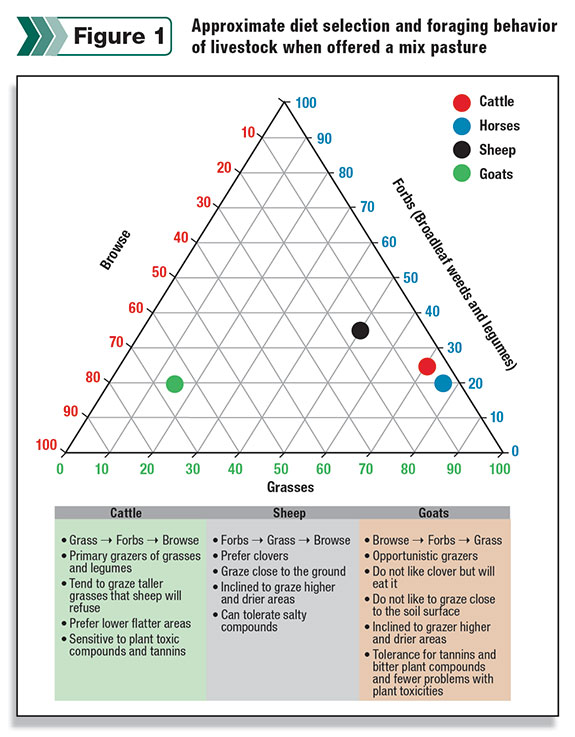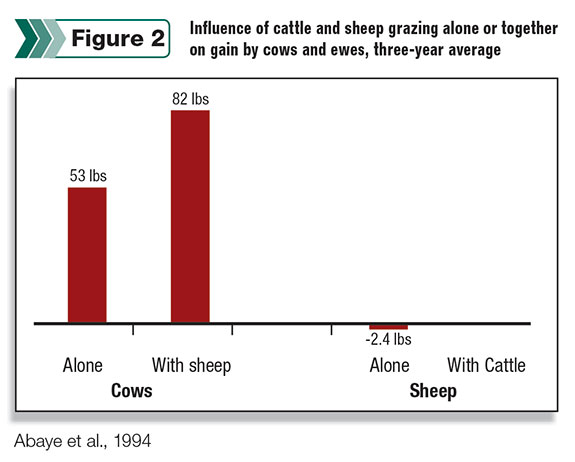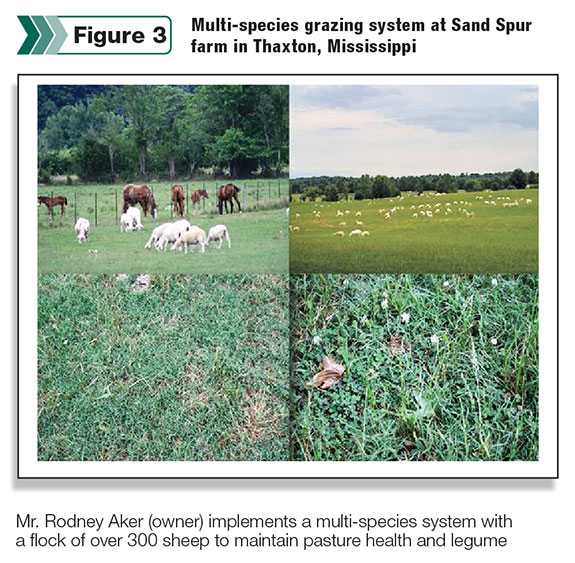Multi-species grazing is the practice of grazing more than one kind of livestock (cattle, sheep and/or goats and horses) in a diverse pasture or land, not necessarily at the same time but within the same grazing season.
This practice has the benefits of promoting more uniform grazing of weeds and forbs, increasing pasture productivity, reducing fuel loads of unwanted vegetation and perhaps reducing predation losses.
This optimizes forage utilization, translating into higher animal production rates, lower costs of production and better returns for producers. Single-species grazing can adversely affect botanical composition. Multi-species grazing takes advantage of different grazing habits and species forage preferences (Figure 1).
Single-species grazing can adversely affect botanical composition. Multi-species grazing takes advantage of different grazing habits and species forage preferences (Figure 1).
Sheep and cattle complement each other as they have different grazing preferences (diets, tastes and tolerances).
Cattle tend to graze more on grass while sheep will graze forbs (broadleaf plants) and will consume weeds that are not palatable to cattle.
On the other hand, goats are more browsers by consuming woody plants, shrubs and vines.
It is important to keep in mind that sheep and goats have higher nutritional needs (goats higher than sheep; sheep higher than cattle) due to higher maintenance requirements based on body size and weight.
These two species tend to select a more nutritious diet.
Therefore, rotating sheep and goats ahead of cattle might be an advantageous grazing strategy. Combining these grazing habits allows for better competition and equilibrium among the plant community.
The problem with grazing only one species on pasture is that the animals will become more selective.
Turning just one species out in the pasture is also not good for internal parasite management. With multi-species grazing, the animals do not have to be in the same pasture at the same time.
They can follow one another in a strategic rotation system, utilizing the various plants at the best time.
Some strategies that can be used in multi-species grazing include: mob grazing (all the animals are run as one group), leader/follower grazing (one flock or herd is run through a paddock first, then followed by a second flock or herd in the same paddock immediately after) and alternating grazing (one flock or herd is run over a group of paddocks during one period of time and then another flock or herd is run at a later time).
In intensively grazed areas, rotating different species can also reduce parasite load since internal parasites are host-specific. The parasite cycle can be broken by alternating species.
Cattle and sheep producers stick to their own pasture, but research has demonstrated that adding sheep to a cattle operation increases on-farm income through the greater output of the combined livestock on a per-acre basis, and this occurs because of better utilization of grassland resources.
Livestock production is higher when species such as cattle and sheep graze together. This is due to the increased carrying capacity of the land and increased individual animal performance.
When adding sheep to cattle-only grazing, animal production could increase by up to 24 percent. In contrast, adding cattle to sheep-only grazing could increase animal production by up to 9 percent.
A study conducted at Virginia Tech indicted that cattle grazed with sheep had increased gains of 55 percent (Figure 2).
A four-year study at North Carolina State with goats grazing pastures containing herbaceous weeds, vines, multiflora rose, blackberry and hardwood sprouts showed that pastures became dominated with grass and clover.
This is one reason that a cattleman can add one ewe or goat to each cow in a pasture and see no productive loss or reduction in gain to the grazing cattle.
Generally, in a diverse pasture system, six to eight goats consume as much as one cow or five to six sheep.
There are certain challenges or limitations that exist which deserve consideration when implementing a multi-species grazing system:
1. Supplemental feeding of trace minerals is an obstacle to consider. Nutrient requirements are different between animal species.
Copper levels in cattle minerals can be toxic if fed to sheep. It is important to place minerals high enough for the cattle to reach them but where sheep cannot.
Another approach is using the leader/follower technique, and moving minerals with each species can eliminate this problem with sheep. One option will be simply grazing goats with cattle rather than sheep.
2. Bullying behavior can also be another issue. Rams could be aggressive to cattle and lambing time could also cause trouble.
The key is to introduce animals for a short period of time and watch carefully for potential bullying problems. It is important to cull animals with this type of behavior to reduce the stress load in the herd or flock.
3. Goats and sheep can be troublesome to maintain in a fenced-in area. Fencing modifications will likely have to be made if small ruminants are added to a cattle operation.
While mature cattle can usually be contained using a one-wire temporary electric fence, this will not be the case with sheep and goats.
It is recommended to use a five-wire fence to contain small ruminants. Woven wire or netted fencing is recommended for the most effective fencing.
Electric fence is also used to keep predators out. Training the sheep or goats to respect a hot wire might alleviate the behavior.
Also, training the sheep to stay with the cows will also minimize fencing issues. Usually the first generation of sheep with cattle in the farm might be an issue, but the new ones that are born and raised with the cattle will feel at ease. 4. Sheep and goats will attract predators, such as coyotes and wild dogs, but pairing them with cattle often reduces this issue since cattle are larger and tend to be more aggressive.
4. Sheep and goats will attract predators, such as coyotes and wild dogs, but pairing them with cattle often reduces this issue since cattle are larger and tend to be more aggressive.
5. Pairing sheep with goats may pose a parasite problem since sheep and goats are affected by the same internal parasites.
Parasites are not transferred from goats to cattle, but some diseases (such as Johne’s disease) can be carried by sheep and transferred to cattle.
There are other exotic diseases that are not very common as well. It is important to get the flock examined by your veterinarian before implementing a multi-species grazing plan.
6. Increased knowledge and management skills are necessary for successful mixed-species operations, and additional labor may be needed.
7. Develop a marketing plan by ensuring there is an infrastructure such as a slaughterhouse or sale barn to sell these small ruminant species.
Decide how to sell the meat through local venues such as a co-op or retail on the farm.
Summary
Multi-species grazing is a very old idea with a modern-day application. Mixed-species grazing could be an alternative to reducing unwanted plant populations in pasture systems for cattle production.
Studies have shown that multi-species grazing, if done right, not only makes good use of land and forage resources but also results in higher animal production.
It is important to use animals that fit your land and forage resources and maintain an ecologically balanced and sustainable grazing system.
Start small to determine if multi-species grazing works for your production program. Visiting other farms that are implementing multi-species gazing and determining if a similar setup might be manageable in your farm could be a good approach.
If a producer does not want to commit to raising sheep or goats, the benefits of multi-species grazing can still be obtained by letting a sheep or goat owner bring animals to the farm periodically to graze certain pastures for effective weed or brush control.
Multi-species grazing can improve pasture utilization, increase pasture quality, increase the carrying capacity of the land, control weeds and brush, and may increase overall production and income of the farm. It is important to consider the benefits and possible obstacles of using this system.
A well-managed multi-species grazing program that is in harmony with the environment will slow and eventually prevent weed spread, enabling grasses and legumes to proliferate and ultimately contribute to increasing carrying capacity on your land. FG
—Excerpts from Mississippi State University Forage News, Vol. 5, No. 12
Rocky Lemus
Extension Forage Specialist
Mississippi State University










